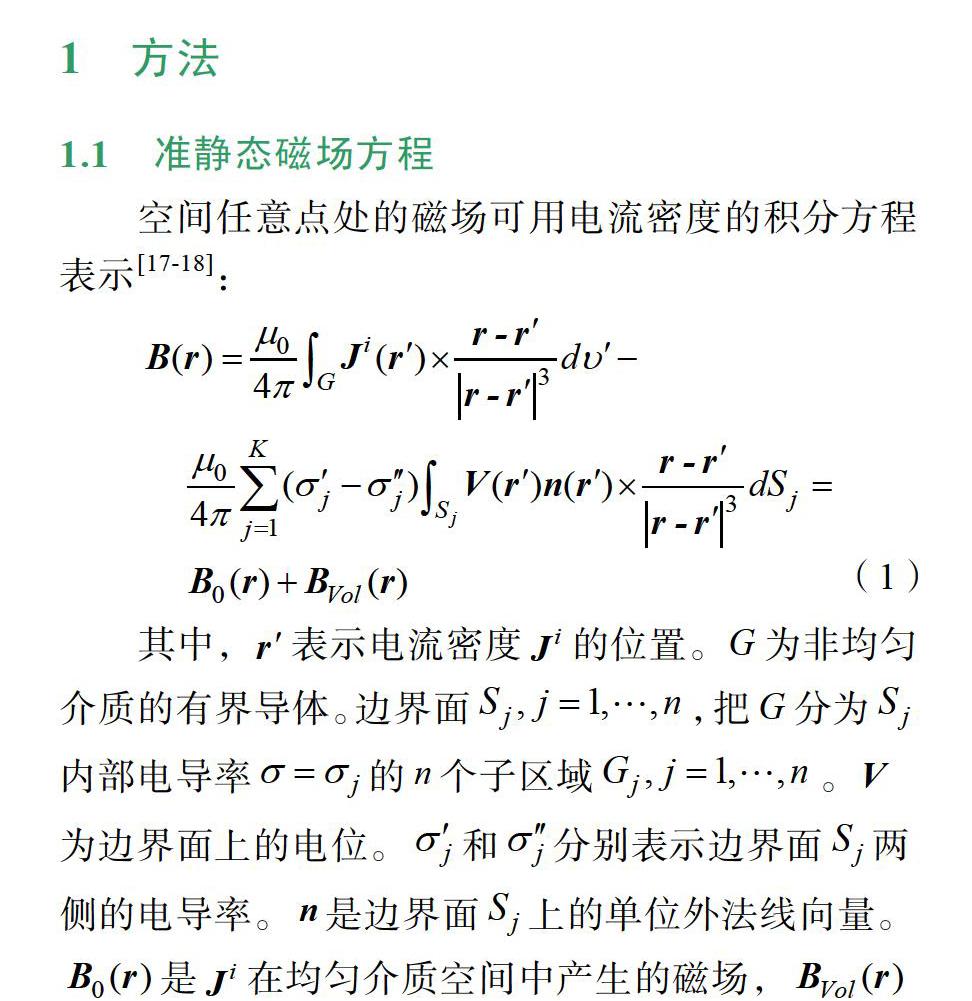自适应时间窗心磁源重构的方法研究
2019-12-19潘宝君朱俊杰
潘宝君 朱俊杰



摘 要: 在使用线性约束最小方差(LCMV)波束形成器重构心脏磁场电流源的研究中,为了解决时间窗过大或者太小造成心脏电流源遗漏的问题,文中提出一种自适应时间窗波束形成的心磁源重构方法。该方法通过不断的调整时间窗得到相应的功率谱,然后求出功率谱中所有的局部极大值,当局部极大值中的最大值和最小值的比值达到最小时,此时对应的时间窗为源重构的最佳时间窗。在仿真实验中,用固定时间窗和自适应时间窗波束形成方法分别对两个和三个电流偶极子产生的心磁数据进行了重构,结果表明,自适应时间窗波束形成方法在两种情况下都具有较好的源重构能力。
关键词: 心磁源重構;波束形成;线性约束最小方差;逆问题;心磁源成像
【Abstract】: In the study of reconstructing the cardiac magnetic field current source using the linear constrained minimum variance (LCMV) beamformer, in order to solve the problem that the current source is missing due to too large or too small time window, an adaptive time window beamforming is proposed. Cardiac magnetic source reconstruction method. The method obtains the corresponding power spectrum by continuously adjusting the time window, and then finds all local maximum values in the power spectrum. When the ratio of the maximum value and the minimum value in the local maximum value reaches a minimum, the corresponding time at this time The window is the best time window for source reconstruction. In the simulation experiment, the cardiac magnetic data generated by two and three current dipoles are reconstructed by fixed time window and adaptive time window beamforming method respectively. The results show that the adaptive time window beamforming method is in two. In all cases, there is better source reconstruction capability.
【Key words】: Magnetocardiography source location; Beamforming; Linear constrained minimum variance; Inverse problem; Magnetocardiography source imaging
0 引言
利用超导量子干涉仪测量技术,可以通过无创伤、非接触且无外加激励的方式测量到人体心脏胸腔表面的磁场信号[1-3]。如何利用测量的心脏磁场数据重构心脏的电流源分布是现阶段心脏电活动逆问题研究的主要任务之一,很多研究学者对心脏的电活动做了深入的研究 [4-8],其目的是获取心脏内部电活动信息辅助诊断心脏疾病。
波束形成器是一种常被用于心磁图和脑磁图源重构中的成像方法。早在1988年,Van Veen就对波束形成器进行了深入的研究[9]。1997年Van Veen等人首次将波束形成的方法引入到脑电的研究中[10],此方法的引入为脑电的研究开辟了新的途径。2001年Sekihara提出了信号子空间特征投影的方法,并将此方法应用到脑磁的研究中,研究表明该方法可
以抑制噪声对源估计的影响[11]。2007年Kiwoong Kim提出了分离表面电位活动区域的空间滤波方法,通过这种方法可以用心磁图显示心肌表面动作电位(AMAP)的活动图[12]。2013年,王伟远等人对减时窗波束形成器源重构方法进行了研究,仿真结果表明,这种减时窗波束形成器能够重构分布时变电流源,并能达到较好的精度[13]。2014年,王伟远等人又提出了多时窗波束形成器的方法,利用多个时窗宽度的数据估计某一时刻心脏磁场源的活动,此方法对突发源具有较好的重构性能,并用该方法重构了左右束支传导阻滞病人的心脏电流源[14]。2017年,Wenxu Sun 等人提出了一种从躯干正面和背面的平行位置重构心脏电流源的方法,结果表明该方法能够提高源空间的分辨率[15]。2018年,周大方等人提出了一种可抑制空间滤波器输出噪声功率增益(SONG)的波束形成方法,该方法具有较好的降噪能力,提高了心磁源重构的分辨率[16]。
本文在线性约束最小方差(LCMV)波束形成器的基础上提出了一种自适应时间窗波束形成源重构方法,仿真实验中,对两组仿真的心磁数据进行源重构,一组数据由两个持续时间很长的电流偶极子产生,另一组数据由两个持续时间很长的电流偶极子和一个持续时间较短的电流偶极子产生。结果表明,自适应时间窗波束形成方法重构出的源与仿真电流偶极子吻合。最后利用该方法对一组健康人的心磁数据进行了源重构。
4 結论
本文在线性约束最小方差波束形成器的基础上提出了自适应时间窗波束形成心磁源重构的方法,该方法通过约束功率谱极值选取较为合适的时间窗。仿真结果表明,自适应时间窗波束形成方法的源重构能力优于给定时间窗的源重构能力,在存在
短时间源的情况下,自适应时间窗波束形成方法仍然有较好的重构性能。文中利用提出的自适应时间窗波束形成方法对一组健康人的心磁数据进行了分析,结果表明QRS波段的心脏电活动主要集中在左心室和左心房部位,T波段的心脏电活动主要集中在左心室,但心房区域也有电活动分布。
该方法在没有噪声的情况下对电流偶极子进行重构有很好的效果,加入噪声后,该方法的源重构精度明显下降,因此,可以在抑制噪声方面对该方法进行改进。文中主要讨论了固定偶极子在同一深度的源重构情况,移动偶极子在不同深度的源重构精度尚需深入的研究。
感谢中国科学院上海微系统与信息技术研究所为本研究提供的心脏磁场数据与核磁共振影像数据。
参考文献
[1]Cohen. D., Edelsack. E. A., Zimmerman, J. E. magne to cardiograms taken inside a shielded room with a super conducting point-contact magnetometer[J]. Applied Physics Letters, 1970, 16(7): 278-280.
[2]Opfer J, Yeo Y, Pierce J, et al. A superco-nducting second- derivative gradiometer[J]. IEEE Transactions on Magnetics, 1974, 10(3): 536-539.
[3]Zhang S L, Wang Y L, Wang H W, et al., Quantitative evaluation of signal integrity for magnetocardiography[J]. Phy sics in Medicine and Biology, 2009, 54(15) 4793-4802.
[4]朱俊杰, 蒋式勤等, 多腔体心脏磁场模型的研究与应用[J]. 物理学报, 2014, 63(5): 058703.
[5]Bruder H., Killmann R., Moshage. W., Bioma-gnetic localization of electrical-current sourc-es in the human heart with rea listic volume conductors using the single-current-dipole m-odel[J]. Physics in Medicine and Biology, 1994, 39(4): 655-668.
[6]Uk Bin lm, Kwon S. S, Kim K, et al., Theoretical analysis of the magnetocardiographic pattern for reentry wave propa gation in a three-dimensional human heart model[J]. Progress in Biophysics and Molecular Biology, 2008, 96(1-3): 339-356.
[7]Wang Q, Ma P, Lu H, et al. , Inverse computation for cardiac sources using single current dipole and current multipole models[J]. Chinaese Physics B, 2009, 18(12): 5566-5574.
[8]Zhu Jun-jie, Jiang S Q, Wang W Y, et al. Cardiac electrical activity imaging of patients with CRBBB or CLBBB in magn etocardiography[J]. Chinese Physics B, 2014, 23(4), 048702.
[9]B. V. Veen. , K. M. Buckley. “Beam-forming: A versatile approach to spatial filtering”[J]. IEEE ASSP Mag. , 1988, 1(5): 4-24.
[10]B. V. Veen, W. V. Drongelen, et al. Localization brain electrical activity via linearly constrained minimum variance spatial filtering[J]. IEEE Trans Biomed. Eng, 1997, 44(9): 867-880.
[11]Sekihara K., Nagarajan S. S, Poeppel D, et al. Reconstructing spatio-temporal activities of neural sources using a MEG vector beamformer technique[J]. Biomedical Engineering, IEEE Transactions on, 2001, 48(7): 760-771.
[12]Kim K, Doosang Kim, Eun-Bo Shim, et al. Separative Surface Potential Activation Beamformer for Localizing Reentrant Excitation of Atrial Fibrillation[C]. Proceedings of NFSI & ICFBI, 2007, 316-319.
[13]王伟远, 赵晨, 林玉章等. 心脏磁场分布电流源重构及其精度分析[J]. 物理学报, 2013, 62(14): 148703.
[14]王伟远, 蒋式勤, 周大方等. 基于多时窗波束形成器方法的心脏磁场信号分析[J]. 物理学报, 2014, 63(24): 248702.
[15]Wenxu Sun, Koichiro Kobayashi. Estimation of Magnetocar diography Current Sources Using Reconstructed Magnetic Field Data[J]. IEEE Transactions on Magnetics , 2017, 53(11): 5100404.
[16]周大方, 張树林, 蒋式勤. 用于心脏电活动成像的空间滤波器输出噪声抑制方法[J]. 物理学报, 2018, 67(15): 158702.
[17]Sarvas J. Basic mathematical and electromagnetic concepts of the biomagnetic inverse problem[J]. Phys. Med. Biol. 1987, 32: 11-22.
[18]Geselowitz D B. On the Magnetic Field Generated Outside an Inhomogeneous Volume Conductor by Internal Current Sources [J]. IEEE Transactions on Magnetics, 1970, 6(2): 346-347.
[19]Vladimirov V S. Equations of Mathematical Physics (New York: Marcel Dekker)[M]//Boundary Value Problems for Elliptic Equations: Discontinuity of the Potential of a Double Layer. 1971: 302-304.
[20]Czapski P, Ramon C, Haueisen J, et al. MCG Simulations of Myocardial Infarctions with a Realistic Heart-Torso Model [J]. IEEE Transactions on Magnetics, 1998, 45(11): 1313-1322.
